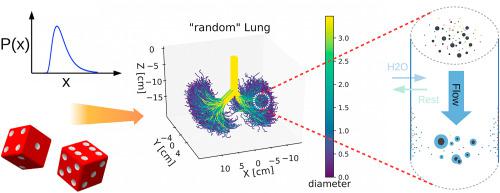当前位置:
X-MOL 学术
›
J. Aerosol Sci.
›
论文详情
Our official English website, www.x-mol.net, welcomes your feedback! (Note: you will need to create a separate account there.)
Aerosol dynamics simulations of the anatomical variability of e-cigarette particle and vapor deposition in a stochastic lung
Journal of Aerosol Science ( IF 4.5 ) Pub Date : 2020-11-01 , DOI: 10.1016/j.jaerosci.2020.105706 Lukas Pichelstorfer , Renate Winkler-Heil , Michael Boy , Werner Hofmann
Journal of Aerosol Science ( IF 4.5 ) Pub Date : 2020-11-01 , DOI: 10.1016/j.jaerosci.2020.105706 Lukas Pichelstorfer , Renate Winkler-Heil , Michael Boy , Werner Hofmann

|
Abstract Electronic cigarette (EC) aerosols are typically composed of a mixture of nicotine, glycerine (VG), propylene glycol (PG), water, acidic stabilizers and a variety of flavors. Inhalation of e-cigarette aerosols is characterized by a continuous modification of particle diameters, concentrations, composition and phase changes, and smoker-specific inhalation conditions, i.e. puffing, mouth-hold and bolus inhalation. The dynamic changes of inhaled e-cigarette droplets in the lungs due to coagulation, conductive heat and diffusive heat/convective vapor transport and particle phase chemistry are described by the Aerosol Dynamics in Containment (ADiC) model. For the simulation of the variability of inhaled particle and vapor deposition, the ADiC model is coupled with the IDEAL Monte Carlo code, which is based on a stochastic, asymmetric airway model of the human lung. We refer to the coupled model as “IDEAL/ADIC_v1.0”. In this study, two different e-cigarettes were compared, one without any acid (“no acid”) and the other one with an acidic regulator (benzoic acid) to establish an initial pH level of about 7 (“lower pH”). Corresponding deposition patterns among human airways comprise total and compound-specific number and mass deposition fractions, distinguishing between inhalation and exhalation phases and condensed and vapor phases. Note that the inhaled EC aerosol is significantly modified in the oral cavity prior to inhalation into the lungs. Computed deposition fractions demonstrate that total particle mass is preferentially deposited in the alveolar region of the lung during inhalation. While nicotine deposits prevalently in the condensed phase for the “lower pH” case, vapor phase deposition is dominating the “no acid” case. The significant statistical fluctuations of the particle and vapor deposition patterns illustrate the inherent anatomical variability of the human lung structure.
中文翻译:

随机肺中电子烟颗粒和蒸气沉积的解剖变异性的气溶胶动力学模拟
摘要 电子烟(EC)气雾剂通常由尼古丁、甘油(VG)、丙二醇(PG)、水、酸性稳定剂和多种香料的混合物组成。电子烟气溶胶吸入的特点是颗粒直径、浓度、成分和相变以及吸烟者特定的吸入条件(即抽吸、含口和快速吸入)的连续改变。由于凝结、传导热和扩散热/对流蒸汽传输和粒子相化学,吸入的电子烟液滴在肺部的动态变化由气溶胶动力学遏制 (ADiC) 模型描述。为了模拟吸入颗粒和气相沉积的可变性,ADiC 模型与基于随机、人肺的不对称气道模型。我们将耦合模型称为“IDEAL/ADIC_v1.0”。在这项研究中,比较了两种不同的电子烟,一种不含任何酸(“无酸”),另一种含有酸性调节剂(苯甲酸),以建立约 7(“较低的 pH”)的初始 pH 值。人类呼吸道中相应的沉积模式包括总的和特定化合物的数量和质量沉积分数,区分吸入和呼出阶段以及冷凝和蒸汽阶段。请注意,吸入的 EC 气雾剂在吸入肺部之前在口腔中发生了显着的改变。计算的沉积分数表明,在吸入过程中,总颗粒质量优先沉积在肺的肺泡区域。虽然尼古丁在“低 pH”情况下普遍沉积在冷凝相中,但气相沉积在“无酸”情况下占主导地位。颗粒和气相沉积模式的显着统计波动说明了人肺结构的固有解剖变异性。
更新日期:2020-11-01
中文翻译:

随机肺中电子烟颗粒和蒸气沉积的解剖变异性的气溶胶动力学模拟
摘要 电子烟(EC)气雾剂通常由尼古丁、甘油(VG)、丙二醇(PG)、水、酸性稳定剂和多种香料的混合物组成。电子烟气溶胶吸入的特点是颗粒直径、浓度、成分和相变以及吸烟者特定的吸入条件(即抽吸、含口和快速吸入)的连续改变。由于凝结、传导热和扩散热/对流蒸汽传输和粒子相化学,吸入的电子烟液滴在肺部的动态变化由气溶胶动力学遏制 (ADiC) 模型描述。为了模拟吸入颗粒和气相沉积的可变性,ADiC 模型与基于随机、人肺的不对称气道模型。我们将耦合模型称为“IDEAL/ADIC_v1.0”。在这项研究中,比较了两种不同的电子烟,一种不含任何酸(“无酸”),另一种含有酸性调节剂(苯甲酸),以建立约 7(“较低的 pH”)的初始 pH 值。人类呼吸道中相应的沉积模式包括总的和特定化合物的数量和质量沉积分数,区分吸入和呼出阶段以及冷凝和蒸汽阶段。请注意,吸入的 EC 气雾剂在吸入肺部之前在口腔中发生了显着的改变。计算的沉积分数表明,在吸入过程中,总颗粒质量优先沉积在肺的肺泡区域。虽然尼古丁在“低 pH”情况下普遍沉积在冷凝相中,但气相沉积在“无酸”情况下占主导地位。颗粒和气相沉积模式的显着统计波动说明了人肺结构的固有解剖变异性。


























 京公网安备 11010802027423号
京公网安备 11010802027423号